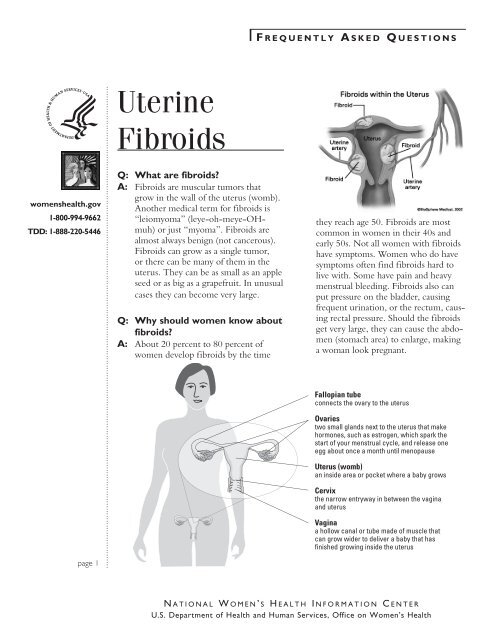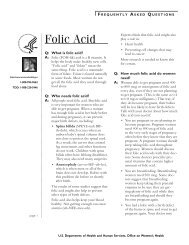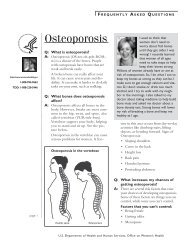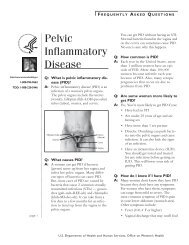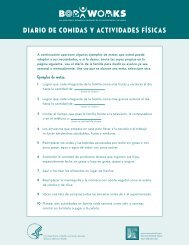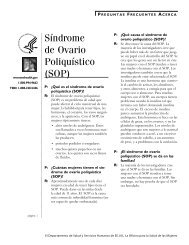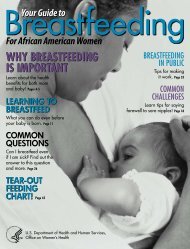Uterine fibroids fact sheet - WomensHealth.gov
Uterine fibroids fact sheet - WomensHealth.gov
Uterine fibroids fact sheet - WomensHealth.gov
You also want an ePaper? Increase the reach of your titles
YUMPU automatically turns print PDFs into web optimized ePapers that Google loves.
F r e q u e n t l y A s k e d Q u e s t i o n s<br />
womenshealth.<strong>gov</strong><br />
1-800-994-9662<br />
TDD: 1-888-220-5446<br />
<strong>Uterine</strong><br />
Fibroids<br />
Q: What are <strong>fibroids</strong><br />
A: Fibroids are muscular tumors that<br />
grow in the wall of the uterus (womb).<br />
Another medical term for <strong>fibroids</strong> is<br />
“leiomyoma” (leye-oh-meye-OHmuh)<br />
or just “myoma”. Fibroids are<br />
almost always benign (not cancerous).<br />
Fibroids can grow as a single tumor,<br />
or there can be many of them in the<br />
uterus. They can be as small as an apple<br />
seed or as big as a grapefruit. In unusual<br />
cases they can become very large.<br />
Q: Why should women know about<br />
<strong>fibroids</strong><br />
A: About 20 percent to 80 percent of<br />
women develop <strong>fibroids</strong> by the time<br />
they reach age 50. Fibroids are most<br />
common in women in their 40s and<br />
early 50s. Not all women with <strong>fibroids</strong><br />
have symptoms. Women who do have<br />
symptoms often find <strong>fibroids</strong> hard to<br />
live with. Some have pain and heavy<br />
menstrual bleeding. Fibroids also can<br />
put pressure on the bladder, causing<br />
frequent urination, or the rectum, causing<br />
rectal pressure. Should the <strong>fibroids</strong><br />
get very large, they can cause the abdomen<br />
(stomach area) to enlarge, making<br />
a woman look pregnant.<br />
page <br />
Fallopian tube<br />
connects the ovary to the uterus<br />
Ovaries<br />
two small glands next to the uterus that make<br />
hormones, such as estrogen, which spark the<br />
start of your menstrual cycle, and release one<br />
egg about once a month until menopause<br />
Uterus (womb)<br />
an inside area or pocket where a baby grows<br />
Cervix<br />
the narrow entryway in between the vagina<br />
and uterus<br />
Vagina<br />
a hollow canal or tube made of muscle that<br />
can grow wider to deliver a baby that has<br />
finished growing inside the uterus<br />
N a t i o n a l W o m e n ’ s H e a l t h I n f o r m a t i o n C e n t e r<br />
U.S. Department of Health and Human Services, Office on Women’s Health
F r e q u e n t l y A s k e d Q u e s t i o n s<br />
womenshealth.<strong>gov</strong><br />
1-800-994-9662<br />
TDD: 1-888-220-5446<br />
page <br />
Q: Who gets <strong>fibroids</strong><br />
A: There are <strong>fact</strong>ors that can increase a<br />
woman's risk of developing <strong>fibroids</strong>.<br />
● Age. Fibroids become more common<br />
as women age, especially during<br />
the 30s and 40s through menopause.<br />
After menopause, <strong>fibroids</strong><br />
usually shrink.<br />
● Family history. Having a family<br />
member with <strong>fibroids</strong> increases<br />
your risk. If a woman’s mother had<br />
<strong>fibroids</strong>, her risk of having them is<br />
about three times higher than average.<br />
● Ethnic origin. African-American<br />
women are more likely to develop<br />
<strong>fibroids</strong> than white women.<br />
● Obesity. Women who are overweight<br />
are at higher risk for <strong>fibroids</strong>.<br />
For very heavy women, the risk is<br />
two to three times greater than average.<br />
● Eating habits. Eating a lot of red<br />
meat (e.g., beef) and ham is linked<br />
with a higher risk of <strong>fibroids</strong>. Eating<br />
plenty of green vegetables seems to<br />
protect women from developing<br />
<strong>fibroids</strong>.<br />
Q: Where can <strong>fibroids</strong> grow<br />
A: Most <strong>fibroids</strong> grow in the wall of the<br />
uterus. Doctors put them into three<br />
groups based on where they grow:<br />
● Submucosal (sub-myoo-KOHzuhl)<br />
<strong>fibroids</strong> grow into the uterine<br />
cavity.<br />
● Intramural (ihn-truh-MYOORuhl)<br />
<strong>fibroids</strong> grow within the wall of<br />
the uterus.<br />
● Subserosal (sub-suh-ROH-zuhl)<br />
<strong>fibroids</strong> grow on the outside of the<br />
uterus.<br />
Some <strong>fibroids</strong> grow on stalks that grow<br />
out from the surface of the uterus or<br />
into the cavity of the uterus. They<br />
might look like mushrooms. These are<br />
called pedunculated (pih-DUHNkyoo-lay-ted)<br />
<strong>fibroids</strong>.<br />
Q: What are the symptoms of<br />
<strong>fibroids</strong><br />
A: Most <strong>fibroids</strong> do not cause any symptoms,<br />
but some women with <strong>fibroids</strong><br />
can have:<br />
● heavy bleeding (which can be heavy<br />
enough to cause anemia) or painful<br />
periods<br />
● feeling of fullness in the pelvic area<br />
(lower stomach area)<br />
● enlargement of the lower abdomen<br />
● frequent urination<br />
● pain during sex<br />
● lower back pain<br />
● complications during pregnancy and<br />
labor, including a six-time greater<br />
risk of cesarean section<br />
● reproductive problems, such as<br />
infertility, which is very rare<br />
N a t i o n a l W o m e n ’ s H e a l t h I n f o r m a t i o n C e n t e r<br />
U.S. Department of Health and Human Services, Office on Women’s Health
F r e q u e n t l y A s k e d Q u e s t i o n s<br />
womenshealth.<strong>gov</strong><br />
1-800-994-9662<br />
TDD: 1-888-220-5446<br />
page <br />
Q: What causes <strong>fibroids</strong><br />
A: No one knows for sure what causes<br />
<strong>fibroids</strong>. Researchers think that more<br />
than one <strong>fact</strong>or could play a role. These<br />
<strong>fact</strong>ors could be:<br />
● hormonal (affected by estrogen and<br />
progesterone levels)<br />
● genetic (runs in families)<br />
Because no one knows for sure what<br />
causes <strong>fibroids</strong>, we also don't know<br />
what causes them to grow or shrink.<br />
We do know that they are under hormonal<br />
control—both estrogen and<br />
progesterone. They grow rapidly during<br />
pregnancy, when hormone levels<br />
are high. They shrink when anti-hormone<br />
medication is used. They also<br />
stop growing or shrink once a woman<br />
reaches menopause.<br />
Q: Can <strong>fibroids</strong> turn into cancer<br />
A: Fibroids are almost always benign (not<br />
cancerous). Rarely (less than one in<br />
1,000) a cancerous fibroid will occur.<br />
This is called leiomyosarcoma (leyeoh-meye-oh-sar-KOH-muh).<br />
Doctors<br />
think that these cancers do not arise<br />
from an already-existing fibroid.<br />
Having <strong>fibroids</strong> does not increase the<br />
risk of developing a cancerous fibroid.<br />
Having <strong>fibroids</strong> also does not increase a<br />
woman’s chances of getting other forms<br />
of cancer in the uterus.<br />
Q: What if I become pregnant and<br />
have <strong>fibroids</strong><br />
A: Women who have <strong>fibroids</strong> are more<br />
likely to have problems during pregnancy<br />
and delivery. This doesn’t mean<br />
there will be problems. Most women<br />
with <strong>fibroids</strong> have normal pregnancies.<br />
The most common problems seen in<br />
women with <strong>fibroids</strong> are:<br />
● Cesarean section. The risk of needing<br />
a c-section is six times greater<br />
for women with <strong>fibroids</strong>.<br />
● Baby is breech. The baby is not<br />
positioned well for vaginal delivery.<br />
● Labor fails to progress.<br />
● Placental abruption. The placenta<br />
breaks away from the wall of the<br />
uterus before delivery. When this<br />
happens, the fetus does not get<br />
enough oxygen.<br />
● Preterm delivery<br />
Talk to your obstetrician if you have<br />
<strong>fibroids</strong> and become pregnant. All<br />
obstetricians have experience dealing<br />
with <strong>fibroids</strong> and pregnancy. Most<br />
women who have <strong>fibroids</strong> and become<br />
pregnant do not need to see an OB<br />
who deals with high-risk pregnancies.<br />
Q: How do I know for sure that I<br />
have <strong>fibroids</strong><br />
A: Your doctor may find that you have<br />
<strong>fibroids</strong> when you see her or him for<br />
a regular pelvic exam to check your<br />
uterus, ovaries, and vagina. The doctor<br />
can feel the fibroid with her or his fingers<br />
during an ordinary pelvic exam, as<br />
a (usually painless) lump or mass on the<br />
uterus. Often, a doctor will describe<br />
how small or how large the <strong>fibroids</strong> are<br />
by comparing their size to the size your<br />
uterus would be if you were pregnant.<br />
For example, you may be told that your<br />
<strong>fibroids</strong> have made your uterus the<br />
size it would be if you were 16 weeks<br />
pregnant. Or the fibroid might be<br />
compared to fruits, nuts, or a ball, such<br />
as a grape or an orange, an acorn or a<br />
walnut, or a golf ball or a volleyball.<br />
Your doctor can do imaging tests to<br />
confirm that you have <strong>fibroids</strong>. These<br />
N a t i o n a l W o m e n ’ s H e a l t h I n f o r m a t i o n C e n t e r<br />
U.S. Department of Health and Human Services, Office on Women’s Health
F r e q u e n t l y A s k e d Q u e s t i o n s<br />
womenshealth.<strong>gov</strong><br />
1-800-994-9662<br />
TDD: 1-888-220-5446<br />
page <br />
are tests that create a "picture" of the<br />
inside of your body without surgery.<br />
These tests might include:<br />
● Ultrasound – uses sound waves to<br />
produce the picture. The ultrasound<br />
probe can be placed on the abdomen<br />
or it can be placed inside the vagina<br />
to make the picture.<br />
● Magnetic Resonance Imaging<br />
(MRI) – uses magnets and radio<br />
waves to produce the picture<br />
● X-rays – uses a form of radiation to<br />
see into the body and produce the<br />
picture<br />
● Cat Scan (CT) – takes many X-ray<br />
pictures of the body from different<br />
angles for a more complete image<br />
● Hysterosalpingogram (hiss-turoh-sal-PIN-juh-gram)<br />
(HSG) or<br />
sonohysterogram (soh-noh-HISStur-oh-gram)—An<br />
HSG involves<br />
injecting x-ray dye into the uterus<br />
and taking x-ray pictures. A sonohysterogram<br />
involves injecting water<br />
into the uterus and making ultrasound<br />
pictures.<br />
You might also need surgery to know<br />
for sure if you have <strong>fibroids</strong>. There are<br />
two types of surgery to do this:<br />
● Laparoscopy (lap-ar-OSS-kohpee)<br />
– The doctor inserts a long,<br />
thin scope into a tiny incision made<br />
in or near the navel. The scope has<br />
a bright light and a camera. This<br />
allows the doctor to view the uterus<br />
and other organs on a monitor during<br />
the procedure. Pictures also can<br />
be made.<br />
● Hysteroscopy (hiss-tur-OSS-kohpee)<br />
– The doctor passes a long, thin<br />
scope with a light through the vagina<br />
and cervix into the uterus. No<br />
incision is needed. The doctor can<br />
look inside the uterus for <strong>fibroids</strong><br />
and other problems, such as polyps.<br />
A camera also can be used with the<br />
scope.<br />
Q: What questions should I ask my<br />
doctor if I have <strong>fibroids</strong><br />
A: ● How many <strong>fibroids</strong> do I have<br />
● What size is my fibroid(s)<br />
● Where is my fibroid(s) located<br />
(outer surface, inner surface, or in<br />
the wall of the uterus)<br />
● Can I expect the fibroid(s) to grow<br />
larger<br />
● How rapidly have they grown (if<br />
they were known about already)<br />
● How will I know if the fibroid(s) is<br />
growing larger<br />
● What problems can the fibroid(s)<br />
cause<br />
● What tests or imaging studies are<br />
best for keeping track of the growth<br />
of my <strong>fibroids</strong><br />
● What are my treatment options if<br />
my fibroid(s) becomes a problem<br />
● What are your views on treating<br />
<strong>fibroids</strong> with a hysterectomy versus<br />
other types of treatments<br />
A second opinion is always a good idea<br />
if your doctor has not answered your<br />
questions completely or does not seem<br />
to be meeting your needs.<br />
Q: How are <strong>fibroids</strong> treated<br />
A: Most women with <strong>fibroids</strong> do not<br />
have any symptoms. For women who<br />
do have symptoms, there are treatments<br />
that can help. Talk with your<br />
N a t i o n a l W o m e n ’ s H e a l t h I n f o r m a t i o n C e n t e r<br />
U.S. Department of Health and Human Services, Office on Women’s Health
F r e q u e n t l y A s k e d Q u e s t i o n s<br />
womenshealth.<strong>gov</strong><br />
1-800-994-9662<br />
TDD: 1-888-220-5446<br />
page <br />
doctor about the best way to treat<br />
your <strong>fibroids</strong>. She or he will consider<br />
many things before helping you choose<br />
a treatment. Some of these things<br />
include:<br />
● whether or not you are having<br />
symptoms from the <strong>fibroids</strong><br />
● if you might want to become pregnant<br />
in the future<br />
● the size of the <strong>fibroids</strong><br />
● the location of the <strong>fibroids</strong><br />
● your age and how close to menopause<br />
you might be<br />
If you have <strong>fibroids</strong> but do not have<br />
any symptoms, you may not need treatment.<br />
Your doctor will check during<br />
your regular exams to see if they have<br />
grown.<br />
Medications<br />
If you have <strong>fibroids</strong> and have mild<br />
symptoms, your doctor may suggest<br />
taking medication. Over-the-counter<br />
drugs such as ibuprofen or acetaminophen<br />
can be used for mild pain. If you<br />
have heavy bleeding during your period,<br />
taking an iron supplement can keep<br />
you from getting anemia or correct it if<br />
you already are anemic.<br />
Several drugs commonly used for birth<br />
control can be prescribed to help control<br />
symptoms of <strong>fibroids</strong>. Low-dose<br />
birth control pills do not make <strong>fibroids</strong><br />
grow and can help control heavy bleeding.<br />
The same is true of progesteronelike<br />
injections (e.g., Depo-Provera®).<br />
An IUD (intrauterine device) called<br />
Mirena® contains a small amount of<br />
progesterone-like medication, which<br />
can be used to control heavy bleeding<br />
as well as for birth control.<br />
Other drugs used to treat <strong>fibroids</strong> are<br />
“gonadotropin releasing hormone<br />
agonists” (GnRHa). The one most<br />
commonly used is Lupron®. These<br />
drugs, given by injection, nasal spray,<br />
or implanted, can shrink your <strong>fibroids</strong>.<br />
Sometimes they are used before surgery<br />
to make <strong>fibroids</strong> easier to remove.<br />
Side effects of GnRHas can include<br />
hot flashes, depression, not being able<br />
to sleep, decreased sex drive, and joint<br />
pain. Most women tolerate GnRHas<br />
quite well. Most women do not get<br />
a period when taking GnRHas. This<br />
can be a big relief to women who have<br />
heavy bleeding. It also allows women<br />
with anemia to recover to a normal<br />
blood count. GnRHas can cause bone<br />
thinning, so their use is generally limited<br />
to six months or less. These drugs<br />
also are very expensive, and some<br />
insurance companies will cover only<br />
some or none of the cost. GnRHas<br />
offer temporary relief from the symptoms<br />
of <strong>fibroids</strong>; once you stop taking<br />
the drugs, the <strong>fibroids</strong> often grow back<br />
quickly.<br />
Surgery<br />
If you have <strong>fibroids</strong> with moderate or<br />
severe symptoms, surgery may be the<br />
best way to treat them. Here are the<br />
options:<br />
● Myomectomy (meye-oh-MEKtuh-mee)<br />
– surgery to remove<br />
<strong>fibroids</strong> without taking out the<br />
healthy tissue of the uterus. It is<br />
best for women who wish to have<br />
children after treatment for their<br />
<strong>fibroids</strong> or who wish to keep their<br />
uterus for other reasons. You can<br />
become pregnant after myomectomy.<br />
But if your <strong>fibroids</strong> were<br />
imbedded deeply in the uterus,<br />
you might need a cesarean section<br />
N a t i o n a l W o m e n ’ s H e a l t h I n f o r m a t i o n C e n t e r<br />
U.S. Department of Health and Human Services, Office on Women’s Health
F r e q u e n t l y A s k e d Q u e s t i o n s<br />
womenshealth.<strong>gov</strong><br />
1-800-994-9662<br />
TDD: 1-888-220-5446<br />
page <br />
to deliver. Myomectomy can be<br />
performed in many ways. It can be<br />
major surgery (involving cutting<br />
into the abdomen) or performed<br />
with laparoscopy or hysteroscopy.<br />
The type of surgery that can be<br />
done depends on the type, size, and<br />
location of the <strong>fibroids</strong>. After myomectomy<br />
new <strong>fibroids</strong> can grow<br />
and cause trouble later. All of the<br />
possible risks of surgery are true for<br />
myomectomy. The risks depend on<br />
how extensive the surgery is.<br />
● Hysterectomy (hiss-tur-EKtuh-mee)<br />
– surgery to remove the<br />
uterus. This surgery is the only<br />
sure way to cure uterine <strong>fibroids</strong>.<br />
Fibroids are the most common<br />
reason that hysterectomy is performed.<br />
This surgery is used when<br />
a woman's <strong>fibroids</strong> are large, if she<br />
has heavy bleeding, is either near or<br />
past menopause, or does not want<br />
children. If the <strong>fibroids</strong> are large, a<br />
woman may need a hysterectomy<br />
that involves cutting into the abdomen<br />
to remove the uterus. If the<br />
<strong>fibroids</strong> are smaller, the doctor may<br />
be able to reach the uterus through<br />
the vagina, instead of making a<br />
cut in the abdomen. In some cases<br />
hysterectomy can be performed<br />
through the laparoscope. Removal<br />
of the ovaries and the cervix at the<br />
time of hysterectomy is usually<br />
optional. Women whose ovaries are<br />
not removed do not go into menopause<br />
at the time of hysterectomy.<br />
Hysterectomy is a major surgery.<br />
Although hysterectomy is usually<br />
quite safe, it does carry a significant<br />
risk of complications. Recovery<br />
from hysterectomy usually takes several<br />
weeks.<br />
● Endometrial Ablation (en-doh-<br />
MEE-tree-uhl uh-BLAY-shuhn)<br />
– the lining of the uterus is removed<br />
or destroyed to control very heavy<br />
bleeding. This can be done with<br />
laser, wire loops, boiling water, electric<br />
current, microwaves, freezing,<br />
and other methods. This procedure<br />
usually is considered minor surgery.<br />
It can be done on an outpatient<br />
basis or even in a doctor’s office.<br />
Complications can occur, but are<br />
uncommon with most of the methods.<br />
Most people recover quickly.<br />
About half of women who have this<br />
procedure have no more menstrual<br />
bleeding. About three in 10 women<br />
have much lighter bleeding. But, a<br />
woman cannot have children after<br />
this surgery.<br />
● Myolysis (meye-OL-uh-siss) – A<br />
needle is inserted into the <strong>fibroids</strong>,<br />
usually guided by laparoscopy, and<br />
electric current or freezing is used to<br />
destroy the <strong>fibroids</strong>.<br />
● <strong>Uterine</strong> Fibroid Embolization<br />
(UFE), or <strong>Uterine</strong> Artery<br />
Embolization (UAE) – A thin<br />
tube is thread into the blood vessels<br />
that supply blood to the fibroid.<br />
Then, tiny plastic or gel particles<br />
are injected into the blood vessels.<br />
This blocks the blood supply to the<br />
fibroid, causing it to shrink. UFE<br />
can be an outpatient or inpatient<br />
procedure. Complications, including<br />
early menopause, are uncommon<br />
but can occur. Studies suggest<br />
<strong>fibroids</strong> are not likely to grow back<br />
after UFE, but more long-term<br />
research is needed. Not all <strong>fibroids</strong><br />
can be treated with UFE. The best<br />
candidates for UFE are women who:<br />
N a t i o n a l W o m e n ’ s H e a l t h I n f o r m a t i o n C e n t e r<br />
U.S. Department of Health and Human Services, Office on Women’s Health
F r e q u e n t l y A s k e d Q u e s t i o n s<br />
womenshealth.<strong>gov</strong><br />
1-800-994-9662<br />
TDD: 1-888-220-5446<br />
●<br />
●<br />
●<br />
●<br />
have <strong>fibroids</strong> that are causing<br />
heavy bleeding<br />
have <strong>fibroids</strong> that are causing<br />
pain or pressing on the bladder<br />
or rectum<br />
don’t want to have a hysterec<br />
tomy<br />
don’t want to have children in<br />
the future<br />
Q: Are other treatments being<br />
developed for uterine <strong>fibroids</strong><br />
A: Yes. Researchers are looking into other<br />
ways to treat uterine <strong>fibroids</strong>. The following<br />
methods are not yet standard<br />
treatments; so your doctor may not<br />
offer them or health insurance may not<br />
cover them.<br />
● MRI-guided ultrasound surgery<br />
shrinks <strong>fibroids</strong> using a high-inten-<br />
sity ultrasound beam. The MRI<br />
scanner helps the doctor locate the<br />
fibroid, and the ultrasound sends<br />
out very hot sound waves to destroy<br />
the fibroid. The ExAblate® 2000<br />
System is a medical device that<br />
uses this method to destroy uterine<br />
<strong>fibroids</strong>.<br />
● Some health care providers use lasers<br />
to remove a fibroid or to cut off the<br />
blood supply to the fibroid, making<br />
it shrink.<br />
● Mifepristone®, and other anti-hormonal<br />
drugs being developed, could<br />
provide symptom relief without<br />
bone-thinning side effects. These are<br />
promising treatments, but none are<br />
yet available or FDA approved.<br />
● Other medications are being studied<br />
for treatment of <strong>fibroids</strong>.<br />
For more Information . . .<br />
For more information about uterine <strong>fibroids</strong>, call womenshealth.<strong>gov</strong> at 1-800-994-9662<br />
or contact the following organizations:<br />
National Institute of Child Health and<br />
Human Development Clearinghouse<br />
Phone Number(s): (800) 370-2943<br />
Internet Address: http://www.nichd.nih.<br />
<strong>gov</strong>/publications/pubs.cfm<br />
American College of Obstetricians<br />
and Gynecologists (ACOG) Resource<br />
Center<br />
Phone Number(s): (202) 863-2518<br />
(Publications requests only)<br />
Internet Address: http://www.acog.org/<br />
Center for <strong>Uterine</strong> Fibroids<br />
Phone Number(s): (800) 722-5520 (Ask<br />
operator for 525-4434)<br />
Internet Address: http://www.<strong>fibroids</strong>.net<br />
National <strong>Uterine</strong> Fibroids Foundation<br />
Phone Number(s): (800) 874-7247<br />
Internet Address: http://www.nuff.org/<br />
page <br />
N a t i o n a l W o m e n ’ s H e a l t h I n f o r m a t i o n C e n t e r<br />
U.S. Department of Health and Human Services, Office on Women’s Health
F r e q u e n t l y A s k e d Q u e s t i o n s<br />
All material contained in this FAQ is free of copyright restrictions, and may be copied,<br />
reproduced, or duplicated without permission of the Office on Women's Health in the<br />
Department of Health and Human Services. Citation of the source is appreciated.<br />
This FAQ was reviewed by:<br />
Steve Eisinger, MD, FACOG<br />
Professor of Family Medicine<br />
Professor of Obstetrics and Gynecology<br />
University of Rochester School of Medicine and Dentistry<br />
womenshealth.<strong>gov</strong><br />
1-800-994-9662<br />
TDD: 1-888-220-5446<br />
Content last updated May 13, 2008.<br />
page <br />
N a t i o n a l W o m e n ’ s H e a l t h I n f o r m a t i o n C e n t e r<br />
U.S. Department of Health and Human Services, Office on Women’s Health


